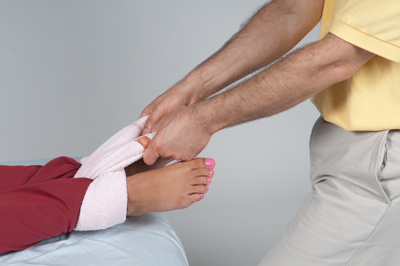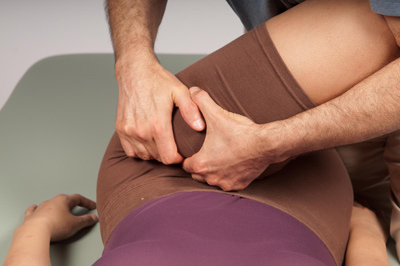 COURSE DESCRIPTION
COURSE DESCRIPTION
Clinical Orthopedic Manual Therapy (COMT) for the Lower Extremity covers the major clinical orthopedic assessment and treatment techniques for the lower extremity. This course is a 2-day hands-on workshop.
Day one begins with palpation assessment of the muscles of the hip joint along with guidelines for proper body mechanics when performing soft tissue manipulation of the muscles of the lower extremity; you will learn how the lower extremity can be worked deeply with little effort. We cover the principles of stretching with the introduction of multiplane stretching. Next we thoroughly workshop stretching the musculature of the hip joint. In-depth palpation of the psoas major is covered. And we finish the day by applying pin and stretch technique to muscles of the lower extremity.
Day two begins with Arthrofascial Stretching (AFS): Soft Tissue Joint Mobilization for all the joints of the lower extremity. AFS is the only effective means of stretching specific nonaxial hypomobilities of the lower extremity joints. We then workshop postural and special orthopedic assessment testing for musculoskeletal conditions of the lower extremity. And we conclude the day with advanced neural inhibition stretching techniques, including Contract Relax (PNF/PIR), Agonist Contract (the basis for AIS), and Contract Relax Agonist Contract stretching techniques.
Clinical treatment strategy and planning as well as precautions and contraindications are also covered. These manual therapy skills will empower you to do effective clinical orthopedic work. Throughout this hands-on workshop, Dr. Joe Muscolino reinforces the underlying mechanisms for each of the assessment and treatment techniques, encouraging critical reasoning skills.
Clinical Orthopedic Manual Therapy for the Lower Extremity is part of the COMT Regional Approach Certification. The other hands-on workshops in this series cover the neck, thoracic spine / ribcage, low back / pelvis, and upper extremity.
COURSE OBJECTIVES
 After attending this workshop, the participant will be able to:
After attending this workshop, the participant will be able to:
Explain and demonstrate the principles of using core body weight and larger muscle groups for efficient body mechanics.
Perform orthopedic assessment tests for the lower extremity to determine the ability to safely perform deep soft tissue manipulation, stretching, and joint mobilization.
Explain the fundamental concepts of stretching and apply these concepts to the musculature of the lower extremity.
Demonstrate how to stretch each of the functional muscle groups of the lower extremity.
Explain and demonstrate how to stretch each of the muscles of the lower extremity in all three cardinal planes.
Explain the physiologic basis for and demonstrate how to perform contract relax (CR; also known as PIR/PNF) stretching, agonist contract (AC) stretching, and contract relax agonist contract (CRAC) stretching techniques.
Explain the physiologic basis for and demonstrate how to perform Arthrofascial Stretching (AFS, Grade IV joint mobilization) of the lower extremity.
DETAILED TIME LINE
Following is the usual time line for this workshop. Note: This time line is often adjusted as needed based on the needs of the particular group.
DAY ONE:
Introductions: 30 min
- Introduction to the content of the class
- Introduction of instructor and workshop participants to each other
Palpation of the anterior hip joint region: 90 min
- Principles of palpation
- TFL, sartorius, rectus femoris, vastus medialis, vastus lateralis, iliacus, psoas major, adductor longus, pectineus, gracilis, medial hamstrings, adductor magnus
- Add in guidelines for soft tissue manipulation of the palpated muscles
- Incorporate proper and efficient body mechanics
Break: 15 min
Palpation of the posterior pelvis: 60 min
- Gluteus maximus, piriformis, quadratus femoris, coccygeus
Basic stretching (concept and body mechanics): 45 min
- Stretching is a mechanical protocol for making a soft tissue longer
- For a muscle of the hip joint, it involves passively bringing the client’s/patient’s thigh into a position that is the opposite of its action(s)
- Concept of stabilization: how to figure out how to stabilize
- Alternate stabilization methods (pelvis: use of core, strap, sit on client/patient)
- Introduce concept of functional groups of muscles (flexors, extensors, abductors, adductors, lateral rotators, medial rotators)
- Incorporate body mechanics with elbow joint in, stacked joints, and using the core
- Concept of multiplane stretching
 Lunch: 60 min
Lunch: 60 min
Workshop stretching all six functional groups of the hip joint: 120 min
- Discuss importance of stretching muscles of the hip joint (reverse actions with postural deviations of the pelvis with effects upon the spine)
- Abductors (side-lying and supine)
- Adductors (with and without knee joint flexed)
- Medial rotators (supine and prone)
- Flexors (two supine methods, two side-lying methods, prone on table and prone on mat)
- Extensors – gluteals (knee to chest)
- Extensors – hamstrings
- Lateral rotators (Figure-4 and Horizontal adduction – with obviating anterior hip region pinching)
Break: 15 min
Palpation of the psoas major abdominal belly: 60 min
- Supine
- side-lying
- ¾ side-lying
- seated, prone
Pin and Stretch: 30 min
- Piriformis, psoas major
Review: 15 min
- Question and answer
DAY TWO:
Introductions: 15 min
- Question and answer over material from Day 1
Treatment strategy: 15 min
Overview of Arthrofascial Stretching (AFS, Grade IV joint mobilization): 30 min
- Explain concept of pinning a bone and moving adjacent bone relative to it
- Steps: 1) Place pin. 2) Bring joint to tension. 3) Mobilize.
- Hold for less than a second, 3-5 oscillations
- Soft tissue pull to trap underlying bone
- Contraindications…
- Use hands in concert
- Utilize body mechanics
Break: 15 min
Workshop AFS foot/ankle: 90 min
- Toe joints (MCP and IP joints)
- Intermetatarsal joints
- Dorsal ankle region
- Therapist contact: middle fingers braced
- Talus traction
- Dorsal to plantar tarsals
- Plantar ankle region
- Therapist contact: pisiform, reinforced thumb
- Dropped navicular
- Dropped cuboid
- Other tarsals
Workshop rest of Lower Extremity mobilizations: 75 min
- Fibula (superior glide with dorsiflexion and inferior glide with plantarflexion; anterior/posterior glide)
- Patella
- Knee joint (around forearm)
- Hip joint (all directions with thigh flexed to 90 degrees)
- Traction (towel traction and Thai move for thigh contact for hip joint)
Lunch: 60 min
Orthopedic assessment testing of the knee joint: 30 min
- Chondromalacia patella (patellofemoral syndrome) test
- Anterior drawer test
- Posterior drawer test
- Medial collateral ligament test
- Lateral collateral ligament test
- Meniscus palpation
- Meniscus test (prone compression)
Deep tissue work to the retinacular fibers around the patella: 15 min
Hyperpronation postural assessment: 75 min
- Discussion of mechanics of foot pronation/supination
- Anterior view assessment
- Posterior view assessment
- Walking assessment
- Kinematic chain analysis up to hip joint (medially rotated lower extremity, genu valgus, dropped pelvis, scoliosis)
Break: 15 min
Advanced stretching: Contract Relax and Agonist Contract: 75 min
- Discuss principles of advanced neural inhibition stretching
- Golgi tendon organ reflex
- Reciprocal inhibition reflex
- Muscle spindle reflex
- Workshop contract relax stretch (hamstrings and piriformis)
- Workshop agonist contract stretch (hamstrings and piriformis)
- Workshop contract relax agonist contract stretch (hamstrings and piriformis)
Review and paperwork: 30 min
- Question and answer
- Fill out evaluation forms
- Hand out Certificates
WORKSHOP PARTICIPANTS SHOULD BRING
1. Massage table with face cradle
2. Stool
3. Bolster and pillow
4. Sheets and face cradle cover
5. Water-based lotion
6. Soft foam cushion (approx. 6×10 inches) or bath towel
7. Loose-fitting shorts (NOT spandex)
Copyright 2014 © The Art and Science of Kinesiology – Dr. Joseph E. Muscolino
